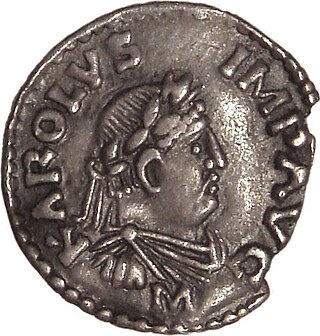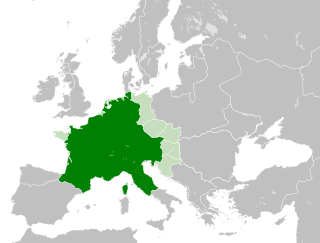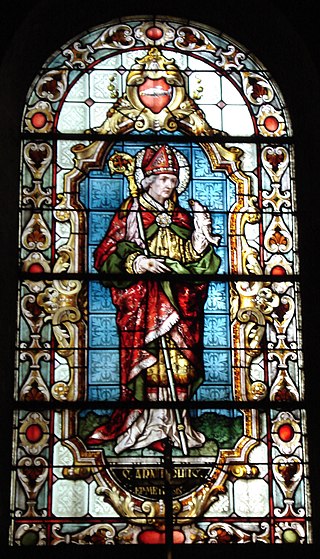
Charlemagne was King of the Franks from 768, King of the Lombards from 774, and Emperor of what is now known as the Carolingian Empire from 800, holding these titles until his death in 814. He united most of Western and Central Europe, and was the first recognised emperor to rule in the west after the fall of the Western Roman Empire approximately three centuries earlier. Charlemagne's reign was marked by political and social changes that had lasting impact on Europe throughout the Middle Ages.

Louis the Pious, also called the Fair and the Debonaire, was King of the Franks and co-emperor with his father, Charlemagne, from 813. He was also King of Aquitaine from 781. As the only surviving son of Charlemagne and Hildegard, he became the sole ruler of the Franks after his father's death in 814, a position that he held until his death except from November 833 to March 834, when he was deposed.

Charles the Bald, also known as Charles II, was a 9th-century king of West Francia (843–877), King of Italy (875–877) and emperor of the Carolingian Empire (875–877). After a series of civil wars during the reign of his father, Louis the Pious, Charles succeeded, by the Treaty of Verdun (843), in acquiring the western third of the empire. He was a grandson of Charlemagne and the youngest son of Louis the Pious by his second wife, Judith.

The Carolingian Empire (800–887) was a Frankish-dominated empire in Western and Central Europe during the Early Middle Ages. It was ruled by the Carolingian dynasty, which had ruled as kings of the Franks since 751 and as kings of the Lombards in Italy from 774. In 800, the Frankish king Charlemagne was crowned emperor in Rome by Pope Leo III in an effort to transfer the Roman Empire from the Byzantine Empire to Western Europe. The Carolingian Empire is sometimes considered the first phase in the history of the Holy Roman Empire.

Austrasia was the northeastern kingdom within the core of the Frankish empire during the Early Middle Ages, centring on the Meuse, Middle Rhine and the Moselle rivers. It included the original Frankish-ruled territories within what had been the northernmost part of Roman Gaul, and cities such as Cologne, Trier and Metz. It also stretched beyond the old Roman borders on the Rhine into Frankish areas which had never been formally under Roman rule. It came into being as a part of the Frankish empire founded by Clovis I (481–511). At the same time, the initial powerbase of Clovis himself was the more Romanized part of northern Gaul, lying southwest of Austrasia, which came to be known as Neustria.

Neustria was the western part of the Kingdom of the Franks during the Early Middle Ages, in contrast to the eastern Frankish kingdom, Austrasia. It initially included land between the Loire and the Silva Carbonaria, in the north of present-day France, with Paris, Orléans, Tours, Soissons as its main cities.

Noyon is a commune in the Oise department, Northern France.

The Carolingian dynasty was a Frankish noble family named after Charles Martel and his grandson Charlemagne, descendants of the Arnulfing and Pippinid clans of the 7th century AD. The dynasty consolidated its power in the 8th century, eventually making the offices of mayor of the palace and dux et princeps Francorum hereditary, and becoming the de facto rulers of the Franks as the real powers behind the Merovingian throne. In 751 the Merovingian dynasty which had ruled the Franks was overthrown with the consent of the Papacy and the aristocracy, and Pepin the Short, son of Martel, was crowned King of the Franks. The Carolingian dynasty reached its peak in 800 with the crowning of Charlemagne as the first Emperor of the Romans in the West in over three centuries. Nearly every monarch of France from Charlemagne's son Louis the Pious till the penultimate monarch of France Louis Philippe have been his descendants. His death in 814 began an extended period of fragmentation of the Carolingian Empire and decline that would eventually lead to the evolution of the Kingdom of France and the Holy Roman Empire.

Childeric III was King of the Franks from 743 until he was deposed in 751 by Pepin the Short. He was the last Frankish king from the Merovingian dynasty. Once Childeric was deposed, Pepin became king, initiating the Carolingian dynasty.

Arnulf of Metz was a Frankish bishop of Metz and advisor to the Merovingian court of Austrasia. He later retired to the Abbey of Remiremont. In French he is also known as Arnoul or Arnoulf. In English he is known as Arnold.

The Kingdom of the Franks, also known as the Frankish Kingdom, the Frankish Empire or Francia, was the largest post-Roman barbarian kingdom in Western Europe. It was ruled by the Frankish Merovingian and Carolingian dynasties during the Early Middle Ages. Francia was among the last surviving Germanic kingdoms from the Migration Period era.
Brunhilda was queen consort of Austrasia, part of Francia, by marriage to the Merovingian king Sigebert I of Austrasia, and regent for her son, grandson and great-grandson.
The Capitulary of Quierzy was a capitulary of Emperor Charles II that had a series of measures to safeguard the administration of his realm during his second Italian expedition, as well as directions for his son Louis the Stammerer, who was entrusted with the government during his father's absence. It has traditionally been seen as the basis on which the major vassals of the kingdom of France such as the counts of Flanders, were enabled to become more independent.
A capitulary was a series of legislative or administrative acts emanating from the Frankish court of the Merovingian and Carolingian dynasties, especially that of Charlemagne, the first emperor of the Romans in the west since the collapse of the Western Roman Empire in the late 5th century. They were so called because they were formally divided into sections called capitula.
Protadius was the mayor of the palace of Burgundy from 604, when he displaced his rival Berthoald, until his death two years later. He was originally the noble lover of Brunhilda, the grandmother of and regent for King Theuderic II. She, however, desired to raise him to status in the kingdom and had him given the patricianship over the lands east of the Jura, whose duke, Wandalmar, had died in 604. She then conspired to do away with Berthoald, mayor of the palace, by sending him with only 300 men to the region of the Seine. Attacked by Clotaire II of Neustria's son, Merovech, and his mayor, Landric, Berthoald died in the ensuing battle when he realised that he had nothing to lose, for he was no longer safe at court.

Ponthion is a commune in the Marne department in north-eastern France.
The royal household of the early kings of the Franks is the subject of considerable discussion and remains controversial. This discussion is aimed at identifying the major categories of participants in the administration and those who made the major historical impacts. Every king of the Franks from Clovis I to Charles the Bald had a large cadre of advisors and bureaucrats that helped implement their regime. These supporters of the crown are frequently unknown, but often are ancestors of the later rulers of France. This is not intended to be a complete list of those supporting the kings but to serve as a guide for further study. A general discussion of the Merovingian and Carolingian dynasties can be found in the associated main articles. See also Government of the Carolingian Empire.
The Capitularies of Charles the Bald represent a series of acts implemented by King Charles to decide and promulgate laws governing public affairs. Capitularies were used extensively by the Merovingian and Carolingian rulers to provide guidance to counts and their subordinate officers in the far-flung reaches of the empire.
The Carolingian Church encompasses the practices and institutions of Christianity in the Frankish kingdoms under the rule of the Carolingian dynasty (751-888). In the eighth and ninth centuries, Western Europe witnessed decisive developments in the structure and organisation of the church, relations between secular and religious authorities, monastic life, theology, and artistic endeavours. Christianity was the principal religion of the Carolingian Empire. Through military conquests and missionary activity, Latin Christendom expanded into new areas, such as Saxony and Bohemia. These developments owed much to the leadership of Carolingian rulers themselves, especially Charlemagne and Louis the Pious, whose courts encouraged successive waves of religious reform and viewed Christianity as a unifying force in their empire.
















